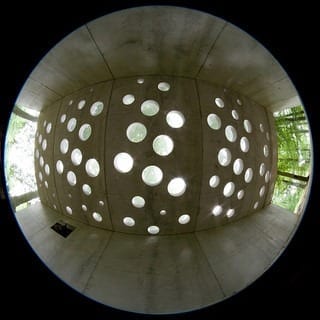
Image: Journal of Micrelectromechanical Systems/colorized by MIT News
Arrays of tiny conical tips that eject ionized materials could fabricate nanoscale devices cheaply
Luis Fernando Velásquez-García’s group at MIT’s Microsystems Technology Laboratories (MTL) develops dense arrays of microscopic cones that harness electrostatic forces to eject streams of ions.
The technology has a range of promising applications: depositing or etching features onto nanoscale mechanical devices; spinning out nanofibers for use in water filters, body armor, and “smart” textiles; or propulsion systems for fist-sized “nanosatellites.”
In the latest issue of the IEEE Journal of Microelectromechanical Systems, Velásquez-García, his graduate students Eric Heubel and Philip Ponce de Leon, and Frances Hill, a postdoc in his group, describe a new prototype array that generates 10 times the ion current per emitter that previous arrays did.
Ion current is a measure of the charge carried by moving ions, which translates directly to the rate at which particles can be ejected. Higher currents thus promise more-efficient manufacturing and more-nimble satellites.
The same prototype also crams 1,900 emitters onto a chip that’s only a centimeter square, quadrupling the array size and emitter density of even the best of its predecessors.
“This is a field that benefits from miniaturizing the components, because scaling down emitters implies less power consumption, less bias voltage to operate them, and higher throughput,” says Velásquez-García, a principal research scientist at MTL. “The topic we have been tackling is how we can make these devices operate as close as we can to the theoretical limit and how we can greatly increase the throughput by virtue of multiplexing, with massively parallel devices that operate uniformly.”
Nanoprinting
“In my opinion, the best nanosystems are going to be done by 3-D printing because it would bypass the problems of standard microfabrication,” Velásquez-García says. “It uses prohibitively expensive equipment, which requires a high level of training to operate, and everything is defined in planes. In many applications you want the three-dimensionality: 3-D printing is going to make a big difference in the kinds of systems we can put together and the optimization that we can do.”
Take me to the complete story . . .
The Latest on: Nanomanufacturing
[google_news title=”” keyword=”Nanomanufacturing” num_posts=”10″ blurb_length=”0″ show_thumb=”left”]
via Google News
The Latest on: Nanomanufacturing
- Three McCormick Faculty Elected to American Academy of Arts and Scienceson April 26, 2024 at 10:09 am
Wei Chen, Mark C. Hersam, and Uri J. Wilensky are among the 250 members elected in 2024, and six from the University. They are recognized for their excellence and commitment to uphold the Academy’s ...
- Chip Industry Week In Reviewon April 19, 2024 at 12:01 am
TSMC, SK hynix HBM deal; Intel's high-NA EUV; big haul for Micron, Samsung; Cadence's new emulation, prototyping systems; architecting chips for HPC; Japan, China's IC output; funding for metrology; ...
- Manchester researchers secure ERC Grants for ground-breaking scientific projectson April 17, 2024 at 7:32 am
Seven Manchester researchers have been awarded prestigious ERC advanced grants for ambitious, curiosity-driven scientific projects ...
- Cornell University Launches Course for Veterans to Expand Microchip Workforce in New York Stateon April 16, 2024 at 8:34 pm
The Cornell NanoScale Science and Technology Facility (CNF) has partnered with two academic institutions to offer a free Microelectronics and Nanomanufacturing Certificate Program to veterans and ...
- Mark Hersam Wins 2024 Mid-Career Research Awardon April 14, 2024 at 5:00 pm
Hersam, Walter P. Murphy Professor of Materials Science and Engineering and chair of the Department of Materials Science and Engineering, is an expert in nanomaterials, nanomanufacturing, scanning ...
via Bing News










